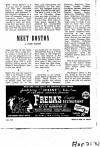
Home Page Meet Boston Menu Index
|
MEET BOSTON Friday, August 21, 1942 in What's New In Town W. J. Sidis |
The “Three Decker” is a curious sort of architecture that has flourished mainly in Boston, though sometimes seen elsewhere. It was originally designed as a form of tenement house―a three-story wooden house with balconies on each floor (usually in back, but sometimes front and back) which are exactly alike, and with a flat roof. The title came from the fancied resemblance of these porches to the decks of a liner. Many single-family houses in some parts of the city are designed in imitation of the three-decker’s lines: while Worcester has outdone itself with a brick building looking exactly like Boston’s three-deckers down to the last detail.
*
Boston has very few cases of what is so frequent in other cities, that is, streets being interrupted for a while, only to resume under the same name further on. In the West, such interruptions and resumptions are very common, and represent parts of streets planned but not built. The same is true in the District of Columbia, where there are cases of streets interrupted and resuming four or five times. Most maps of those places represent the planned but uncompleted course of the streets by dotted lines. Boston is almost free from this nuisance. There are exceptions; for instance, Metropolitan Avenue in Hyde Park stops at the Neponset River, and resumes at the farther side of the river. But, on the whole, Boston differs from cities in that, once you have found the right street, you need only to follow it to your destination.
*
According to an unpublished Boston guide-book,* the Boston Postal District includes besides the official city, Arlington, Belmont, Braintree, Brookline, Cambridge, Chelsea, Everett, Lexington, Malden, Medford, Melrose, Milton, Needham, Newton, Quincy, Revere, Somerville, Stoneham, Waltham, Watertown, Wellesley, Weston, Weymouth and Winthrop. This information may come in handy if you want to know how much postage to put on a letter, as there is a 2˘ postage rate within this whole district. The Boston telephone book, according to the same source, covers not only the Postal District, but also Bedford, Canton, Cohasset, Dedham, Hingham, Holbrook, Hull, Lincoln, Norwood, Randolph, Reading, Wakefield, Westwood and Woburn, The Postal District―largest in the country―covers 26 municipalities; while the telephone district takes in an even forty.
*
That church-looking building of the Exeter Street Theater used to be a spiritualist temple some fifty years ago.
*
Washington Street is the only street in the city that traverses Boston from waterfront to the south boundary, and to split the city entirely in two.
________
* This is Sidis's guide book, previously cited in "Meet Boston," June 26, 1942.